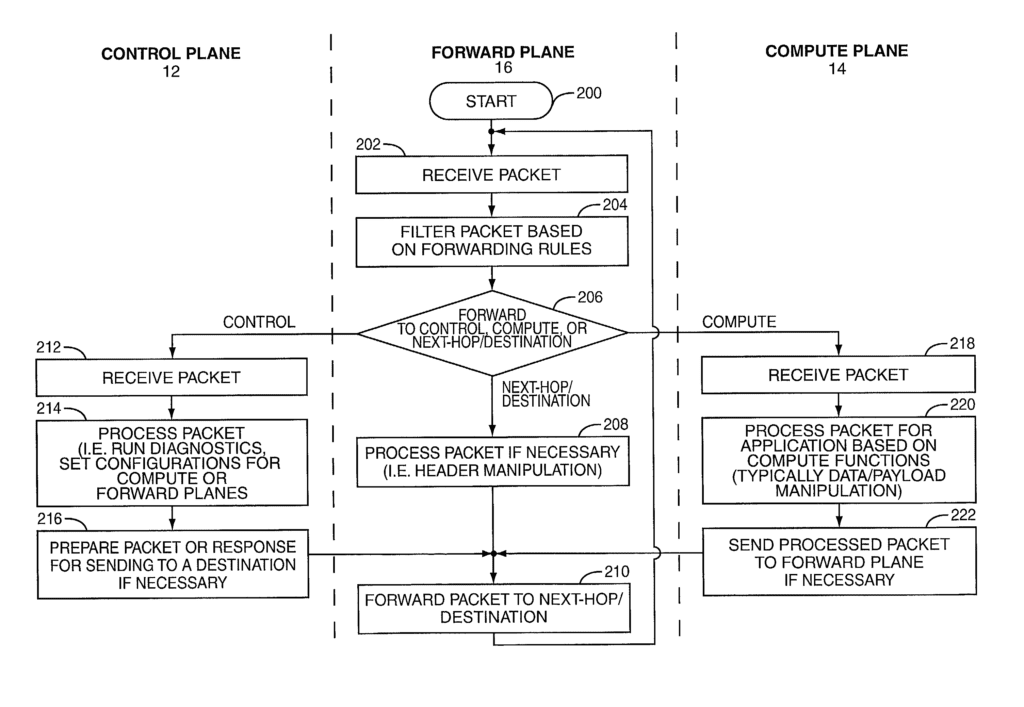ABSTRACT
The present invention facilitates routing traffic over a network and distributing application level support among multiple routing devices during routing.
Routing nodes are configured to process the content of the traffic to provide the requisite application level support. The traffic is routed, in part, based on the resources available for providing the processing. The processing of the traffic may be distributed throughout the network based on processing capacity of the routing nodes at any given time and given the amount of network congestion.

Distributed computation in network devices
An Inventor: Dr. Tal Lavian
FIELD OF THE INVENTION
The present invention relates to processing and routing packets in a network, and in particular, to distributing application level processing among one or more routing devices during high-speed routing.
BACKGROUND OF THE INVENTION
Existing routers have limited computation capacity and offer little or no application layer support during routing. These routers are typically divided into a control plane and a forward plane.
The control plane is used for basic setup and control of the router. For example, the control plane is generally used to establish routing tables used by the forward plane. The forward plane receives packets, processes the packets based on the routing tables set up by the control plane, and delivers the packets to the next-hop address or the final destination, depending on the termination point for each packet.
The forward plane in existing routers is typically limited to packet delivery based on basic header analysis and manipulation. Historically, application layer support, such as that requiring analysis or manipulation of the packet’s payload, has been avoided. Those specially configured devices capable of providing application processing, such as firewalls, are uniquely configured for the special application wherein the routing speeds for normal routing in the forward plane are significantly impacted or the control plane is uniquely adapted to handle such processing. In either case, basic routing capability of the forward plane is inhibited. Thus, traditional network routers typically do not provide application level processing, and routing devices providing such support are only used in limited applications.
Nortel Networks Limited is developing routing devices capable of providing application level processing without significantly impacting forwarding performance for the packets being processed at an application level or for those requiring only basic routing. These routing devices are capable of providing various types of application level support to facilitate any number of functions or network services.
Although these routing devices provide application level support during routing, for any given traffic flow, a single device may not have the computational capacity to provide all of the processing for a given traffic flow. The capacity may be limited based on the routing device’s capability or the processing required for concurrent traffic flows. Further, congested networks incorporating routing devices capable of providing application level support would be more efficient if processing could be distributed to less congested devices, which are comparably capable.
Thus, there is a need to distribute processing for application level support among routing devices capable of providing such support. There is a further need to be able to detect congested routing devices and direct traffic to routing devices with capacity for application level support without significantly impacting routing efficiency and speeds.
SUMMARY OF THE INVENTION
The present invention facilitates routing traffic over a network and distributing application level support among multiple routing devices during routing.
Routing nodes are configured to process the content of the traffic to provide the requisite application level support. The traffic is routed, in part, based on the resources available for providing the processing. The processing of the traffic may be distributed throughout the network based on processing capacity of the routing nodes at any given time and given the amount of network congestion.
When traffic is routed, processing resources required for delivery of the traffic from a source to the destination are determined. Since multiple routing paths may exist, one or more paths between the source and destination capable of providing the requisite application level support during routing are identified. Next, the available processing resources in the possible paths are compared with the resources required for routing. One or more paths are then selected to optimize routing and minimize congestion. Upon selection of the one or more paths, the traffic may be routed and processed accordingly.
The requisite application level processing may be distributed among multiple routing nodes and paths to make sure that sufficient resources are available and delivery does not negatively affect other traffic. The distribution of the processing is preferably based on available resources and perhaps on other network conditions bearing on the processing and routing performance for the particular traffic flow, the network in general, or a combination thereof.
Those skilled in the art will appreciate the scope of the present invention and realize additional aspects thereof after reading the following detailed description of the preferred embodiment in association with the accompanying drawing figures.
Dr. Tal Lavian offers insightful and decisive expertise as a telecommunications expert witness and network communications expert witness.